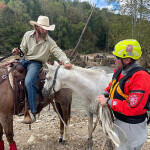Learn effective tips to keep your horse hydrated, prevent dehydration, and handle signs of heat stress with these expert-approved methods for equine care.
When summer arrives, one of the greatest challenges for horse owners is equine hydration. As temperatures soar, ensuring our four-legged partners are drinking enough water becomes essential, but it’s often easier said than done. Some horses struggle with water intake both at home and on the road, while others only have issues when being hauled. With rising temperatures and the summer competition season in full swing, now is the perfect time to review some tips and tricks for keeping horses properly hydrated.
Signs of a Properly Hydrated Horse
How can you tell if your horse is getting enough water? Physical signs of a hydrated horse include skin that “bounces back” when pinched, rather than staying slack. Gums that turn white when gently pressed but quickly return to pink. Urine that is yellow or clear. If your horse shows these signs, they are likely well-hydrated. However, it’s always important to monitor for dehydration, especially in hot weather.
Signs of a Dehydrated Horse
Dehydrated horses may show symptoms such as lethargy, reduced skin elasticity, loss of appetite, dry gums, high heart rates, and sunken eyes and flanks. The Redmond Equine Blog emphasizes that dehydration can kill a horse in just a few days. They recommend horses never go without water for more than three to five hours. Dehydration is a serious concern, and owners should be aware of its common causes.
Causes of Dehydration
Horses may refuse to drink water for various reasons. Stress, triggered by factors such as new locations, trailer hauling, or new pasture companions, is a common cause. Temperature swings can also deter horses from drinking if their water becomes too warm or cold for their liking. Unclean or stale water can lead to refusal as well, so it’s crucial to provide fresh, clean water. Additionally, water that tastes or smells different from what they’re used to may also cause issues. When traveling, bringing a few jugs of “home” water can help ease this adjustment. Dehydration can also occur even when horses are drinking water. Excessive sweating, diarrhea, or medical issues such as ulcers can lead to fluid loss.
Ways to Maintain Hydration
Fortunately, there are many strategies and products available to help promote hydration. Increase salt intake with salt licks, supplements, or by adding salt to feed. This naturally encourages thirst. Soak feed and hay in water to boost water intake. Keep water buckets and troughs at a consistent temperature, ideally between 45°F and 65°F. Use lighter-colored water buckets, as studies indicate horses prefer them over dark ones. When traveling, stop every two to three hours to offer water. Flavoring water with natural additives, electrolytes, or sweeteners like apple juice can also encourage drinking. The Redmond Equine Blog suggests flavoring water a few days before a trip and continuing to use the same flavor at your destination to mask unfamiliar tastes and provide a comforting sense of home. Electrolyte supplements are another excellent way to combat dehydration, as they replace lost nutrients. Meanwhile, salt supplements help stimulate thirst. If a horse shows signs of chronic or severe dehydration, contact a veterinarian immediately.
Conclusion
Whether you’re dealing with a stubborn horse, a sick horse, or just one struggling with summer heat, there are plenty of methods to keep your equine companion hydrated. The saying goes, “You can lead a horse to water, but you can’t make him drink.” Then again, with the right tricks, maybe you can!









